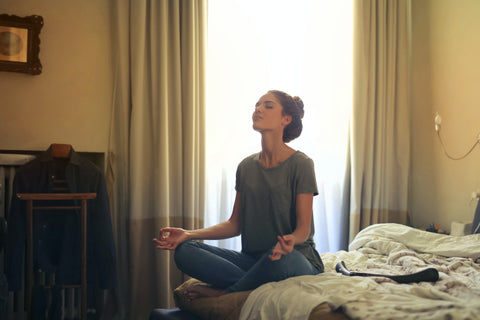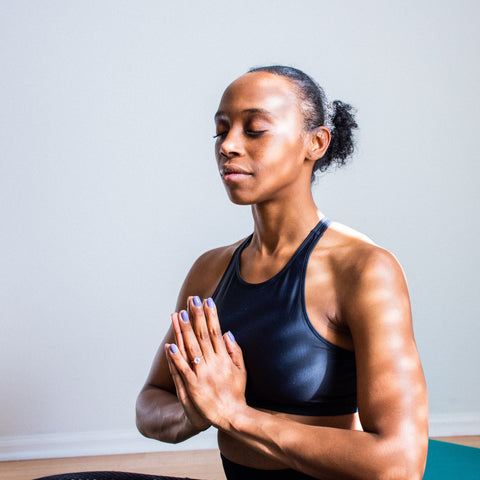Your Cart is Empty
- Shop
- About
- Learn
- Free Domestic Shipping Over $50
- +1(800)929-8935
- Login
- Free Domestic Shipping Over $50
- +1(800)929-8935

 Breath is one of the body’s most powerful tools. It is through breathing that we bring vital oxygen to our bloodstream. It is unique amongst our body’s systems as it can be automatic (when we sleep) or controlled (when we are awake). Even when we’re not thinking about breathing, our bodies still remember to do it.
Breath is one of the body’s most powerful tools. It is through breathing that we bring vital oxygen to our bloodstream. It is unique amongst our body’s systems as it can be automatic (when we sleep) or controlled (when we are awake). Even when we’re not thinking about breathing, our bodies still remember to do it.
Our breath is malleable. It can fit into during conversations or meals. We even use our breath to communicate with others through gasps, sighs, or yawns. The way we breathe closely entwined with the rest of our body, and through mastery of breathing, we can fight stress and regulate our minds. Breathing techniques to help pull your breath in line and calm yourself are easy to do. All it takes is a small commitment of time.
One of the most significant benefits of breathing techniques as a form of mind and body regulation is their ability to work instantly. If you try practicing breathing to calm down or de-stress, you will often feel the benefits before you are through with the exercise.
In this article, we’ll focus on the art of breathing and how different breathing techniques can help you recenter yourself during the day. Taking a few moments during a stressful time to breathe meaningfully can help you put things in perspective and help you focus. Breathing techniques can be a crucial part of emotional and physical stability.
 Our breath is intricately tied to our emotional state, and it’s a two-way street. Stressful situations make our breath catch, shortening our breathing to panicked, shallow gasps. However, with a little practice, we can make this effect flow in reverse. So when we feel stressed, panicked, or upset, controlled breathing can calm us down, telling the brain that all is well and allowing us to focus.
Our breath is intricately tied to our emotional state, and it’s a two-way street. Stressful situations make our breath catch, shortening our breathing to panicked, shallow gasps. However, with a little practice, we can make this effect flow in reverse. So when we feel stressed, panicked, or upset, controlled breathing can calm us down, telling the brain that all is well and allowing us to focus.
All thanks to the complex system of neurons in our brains that control breathing. Much like the natural pacemakers in our hearts, specific areas of the brain target breathing. This “pacemaker of the brain” is not yet fully understood. Still, continuous studies show us just how effective communication occurs between our brains and our breath¹.
“In through the nose and out through the mouth.”
Most of us default to breathing with our noses. When we breathe through our noses, we can absorb more oxygen. Your mouth is not as conducive to getting oxygen into your body as your nose is like most mammals do. Many other mammals, such as horses, actually cannot breathe through their mouths at all.
Mouth breathing is also more likely to expose you to allergens and interfere with your body’s carbon dioxide levels. The Bohr Effect describes when you breathe through your mouth, the pH levels in your blood are susceptible to unwanted change that can lead to hypoxia². Also, breathing through one’s mouth can have adverse developmental effects on children, sometimes elongating their face shape as they grow and impairing respiratory patterns.
None of this is to say that the occasional gasp is going to hurt you. There are some situations where you should breathe through your mouth. However, during normal activities (including exercise), you should strive to breathe through your nose.
 The most common breathing mistakes include breathing with your mouth, breathing shallowly, and breathing quickly. You’ll notice that these are all symptoms of being stressed, angry, or afraid. If you continue to breathe in this manner throughout the day, you’ll effectively be keeping your brain in a constant state of moderate stress.
The most common breathing mistakes include breathing with your mouth, breathing shallowly, and breathing quickly. You’ll notice that these are all symptoms of being stressed, angry, or afraid. If you continue to breathe in this manner throughout the day, you’ll effectively be keeping your brain in a constant state of moderate stress.
Another common breathing mistake is focusing too much on the chest. When we take a deep breath, we tend to suck in our bellies and puff out our chests, but this is counterintuitive to deep breathing. Breathing with your chest doesn’t engage your diaphragm and is less calming than deeper belly breaths.
Just like physical exercise, there are multiple breathing techniques, each a little different from the last. Some methods are more effective in certain situations. You may find that one technique is easiest for you or gets you the best results. Give each a try in a suitable circumstance and try to find your ideal space.
 The 4-7-8 exercise is meant for relaxation and reducing negative feelings like anger and food cravings. It is a favorite of those who are trying to cut unhealthy foods from their diet. The 4-7-8 exercise is also commonly used for improved sleep.
The 4-7-8 exercise is meant for relaxation and reducing negative feelings like anger and food cravings. It is a favorite of those who are trying to cut unhealthy foods from their diet. The 4-7-8 exercise is also commonly used for improved sleep.
The basics of the 4-7-8 are that you exhale twice for each inhales and timing your breath with slow counting.
Sit up straight. Sitting up straight is essential with all breathing techniques as it helps improve blood flow and opens your diaphragm.
Hold your tongue against the back of your teeth. You must relax the muscles in your face and mouth.
Breathe in through the nose for four seconds.
Hold your breath for seven seconds.
Breathe out through your mouth for 8 seconds
Repeat four times. Do not overdo it on your first try, or you may become lightheaded. You can work up to longer cycles as you keep practicing.
Though commonly used before bedtime, many people also use the 4-7-8 Breathing Technique during the daytime to calm their nerves or banish negative thoughts. Find how this breathing technique best works for you and practice for about a month before trying a different technique or increasing your cycles.
Intended to help focus on slowing your breath, Box Breathing increases deliberation. It is often useful during bouts of physical training. But even if you’re not hitting the gym, this breathing exercise may help you subdue food or nicotine cravings and increase overall focus determination.
Box Breathing is a symmetrical breathing exercise that can help even out bodily functions like body temperature.
Straighten your spine and relax your muscles.
Inhale for five seconds.
Hold your breath for five seconds.
Exhale for five seconds.
Hold your breath for five seconds.
Repeat for a period of one to three minutes
This exercise will create a “box” of breathing, where each inhalation and exhalation is identical and buffered by a matching period of no breath. As with all breathing exercises, you should breathe through your nose and allow your diaphragm to expand and retract after your exhalations.
Try this exercise when you feel nervous or anxious, such as before a significant conversation or event.
 Precisely what it sounds like, Lion’s breath is an exaggerated breath that helps you roar out your emotions like a lion. It is often employed to manage emotions, mainly frustration and anger. If you can give yourself a minute to do Lion’s Breath before you address an issue, you may find yourself in a calmer state of mind. Lion’s breath takes the place of a verbal outburst that may otherwise be directed at a person.
Precisely what it sounds like, Lion’s breath is an exaggerated breath that helps you roar out your emotions like a lion. It is often employed to manage emotions, mainly frustration and anger. If you can give yourself a minute to do Lion’s Breath before you address an issue, you may find yourself in a calmer state of mind. Lion’s breath takes the place of a verbal outburst that may otherwise be directed at a person.
Take a deep breath.
Hold your breath for a few seconds.
Exhale loudly, “roaring” if you feel like it.
Optionally, you may unclench your jaw, stick out your tongue, close your eyes, or any other combination of dramatic effects as you breathe out.
Repeat if you wish.
Lion’s breath is a very straightforward breathing technique. You can make it your own. You can be as dramatic as you want (people usually perform this breathing technique away from others).
Lion’s breath is quite common in yoga classes, where it is used to help people let go of burdensome anger or frustration. Lion’s breath is not for the shy, and you may have to work your way up to being comfortable with it.
Belly Breathing is the most basic form of breathing technique. You don’t need to worry about counting or closely monitoring your breath. With Belly Breathing, you simply breathe slowly while engaging your diaphragm. The technique is used to help people handle stress and improve overall well being. If you’re new to practiced breathing, you may want to start with this technique.
Get comfortable. Most people sit or lie down, although you should do whatever is the most relaxing for you. You should strive for good posture without stressing yourself over sitting or laying “perfectly” straight. Comfort is key.
Bend your knees. No matter which position you assume, bending your knees will help everything flow better.
Place one hand on your upper chest and the other on your belly.
Breathe in through your nose and out through your mouth. Do so slowly, and feel your belly rise with each inhalation and lower with each exhalation. Your chest should remain mostly still. The key is to get the breath flowing through your gut, not your chest.
Continue for a few minutes (up to ten). Repeat throughout the day if needed, without overdoing it. One to four sessions a day is optimal.
Diaphragmatic breathing (also called abdominal or belly breathing) has been the subject of numerous studies, most of which have found a potential for this breathing technique to have multiple mental and physiological benefits. A controlled study from 2017 found that belly breathing showed promise to improve cognition and handle stress³.
Most breathing techniques implement belly breathing to some extent. Learning to breathe deeply while utilizing your diaphragm is a vital part of deep breathing exercises.
 The technique of equal breathing comes from yoga. You may hear it referred to in mediation circles as Sama Vritti Pranayama. Equal breathing is very similar to box breathing. Your exhalation and inhalation should last for the same amount of time. The main differences are that you do not need to hold your breath for an equal length of time. Unlike box breathing, equal breathing allows you a more extensive range of experimentation with how long each breath lasts.
The technique of equal breathing comes from yoga. You may hear it referred to in mediation circles as Sama Vritti Pranayama. Equal breathing is very similar to box breathing. Your exhalation and inhalation should last for the same amount of time. The main differences are that you do not need to hold your breath for an equal length of time. Unlike box breathing, equal breathing allows you a more extensive range of experimentation with how long each breath lasts.
Sit or lie down in a comfortable position. Sitting is ideal, but know your own body.
Take a few minutes to focus on your natural breathing without trying to change it.
Slow down your breath and begin to count.
Inhale for a count of several seconds (5 seconds is an excellent place to start, but the length of each breath is up to you).
Pause for a moment after inhaling. You do not have to count your pause.
Exhale for the same count as your inhalation.
Pause for a moment.
Repeat for several minutes, adjusting your counts as you need.
Equal breathing helps to reduce stress levels and help regulate emotions and mood. Some smaller studies have come out recently with evidence to suggest that breathing exercises like Sama Vritti Pranayama may benefit your immune system⁴.
 There are many other breathing techniques out there to try, and even more possibilities for implementing them. Some people find that dedicating a space of time every day to practice breathing techniques is best. Still, others maintain consistency by working their breathing techniques into activities that already exist within their schedule.
There are many other breathing techniques out there to try, and even more possibilities for implementing them. Some people find that dedicating a space of time every day to practice breathing techniques is best. Still, others maintain consistency by working their breathing techniques into activities that already exist within their schedule.
There’s no wrong answer. Find the breathing practices that work best for you, and remember to include them in your self-care regimen. If you’re too busy to sit for a yoga class or other meditative exercise, try adding these breathing techniques to your evening bath or lunch break. Remember, you don’t have to spend hours practicing to get the benefits of controlled breathing exercises.
(1) Bai, N (August 2017) Searching for the Brain Cells That Control Our Breathing
(2) Pathway Medicine; Bohr Effect
(3) Ma, X; Yue, ZQ; Gong, ZQ; Zhang, H.; Duan, NY; Shi, YT; Wei, GX; Li, YF (June 2017) The Effect of Diaphragmatic Breathing on Attention, Negative Affect and Stress in Healthy Adults
(4) Schultz, C (May 2014) Breathing Deeply May Actually Boost Your Body’s Immune System